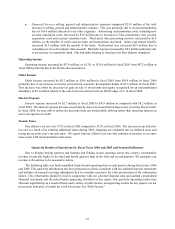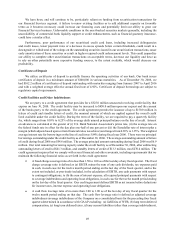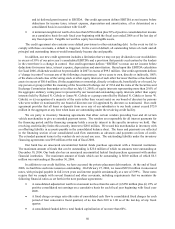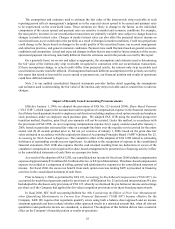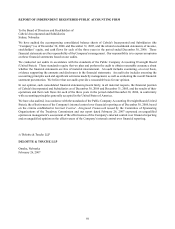Cabela's 2006 Annual Report Download - page 54
Download and view the complete annual report
Please find page 54 of the 2006 Cabela's annual report below. You can navigate through the pages in the report by either clicking on the pages listed below, or by using the keyword search tool below to find specific information within the annual report.50
and (e) deferred grant income) to EBITDA. Our credit agreement defines EBITDA as net income before
deductions for income taxes, interest expense, depreciation and amortization, all as determined on a
consolidated basis in accordance with GAAP.
• A minimum tangible net worth of no less than $350 million plus 50% of positive consolidated net income
on a cumulative basis for each fiscal year beginning with the fiscal year ended 2006 as of the last day of
any fiscal quarter. Tangible net worth is equity less intangible assets.
The credit agreement also contains cross default provisions to other outstanding debt. In the event we fail to
comply with these covenants, a default is triggered. In the event of default, all outstanding letters of credit and all
principal and outstanding interest would immediately become due and payable.
In addition, our new credit agreement includes a limitation that we may not pay dividends to our stockholders
in excess of 50% of our prior year’s consolidated EBITDA and a provision that permits acceleration by the lenders
in the event there is a change in control. Our credit agreement defines “EBITDA” to mean our net income before
deductions for income taxes, interest expense, depreciation and amortization. Based upon this EBITDA calculation
for fiscal 2006, dividends would not be permissible in 2007 in excess of $99.5 million. Our credit agreement defines
a “change in control” to mean any of the following circumstances: (a) we cease to own, directly or indirectly, 100%
of the shares of each class of the voting stock or other equity interest of each other borrower that has or has had total
assets in excess of $10.0 million; (b) the acquisition or ownership, directly or indirectly, beneficially or of record, by
any person or group (within the meaning of the Securities Exchange Act of 1934 and the rules of the Securities and
Exchange Commission thereunder as in effect on July 15, 2005), of equity interests representing more than 25.0% of
the aggregate ordinary voting power represented by our issued and outstanding equity interests (other than equity
interests held by Richard N. Cabela or James W. Cabela or a group controlled by Richard N. Cabela or James W.
Cabela); or (c) occupation of a majority of the seats (other than vacant seats) on our board of directors by persons
who were neither (i) nominated by our board of directors nor (ii) appointed by directors so nominated. Our credit
agreement provides that all loans or deposits from us or any of our subsidiaries to our bank cannot exceed $75.0
million in the aggregate at any time when loans are outstanding under the revolving credit facility.
We are party to inventory financing agreements that allow certain vendors providing boat and all terrain
vehicle merchandise to give us extended payment terms. The vendors are responsible for all interest payments for
the financing period and the financing company holds a security interest in the specific inventory we hold. Our
revolving credit facility limits this security interest to $20.0 million. We record this merchandise in inventory with
an offsetting liability in accounts payable in the consolidated balance sheet. The loans and payments are reflected
in the financing section of our consolidated cash flow statements as advances and payments on lines of credit.
The extended payment terms to the vendors do not exceed one year. The outstanding liability under the inventory
financing agreements was $9.8 million at the end of fiscal 2006.
Our bank has an unsecured uncommitted federal funds purchase agreement with a financial institution.
The maximum amount of funds that can be outstanding is $25.0 million of which no amounts were outstanding at
December 30, 2006. Our bank also has an unsecured uncommitted federal funds purchase agreement with another
financial institution. The maximum amount of funds which can be outstanding is $60.0 million of which $6.5
million was outstanding at December 30, 2006.
In addition to our credit facilities, we have accessed the private placement debt markets. At the end of fiscal
2006, we had three such note issuances outstanding. On February 27, 2006, we issued $215.0 million in unsecured
notes, with principal payable in full in ten years and interest payable semiannually at a rate of 5.99%. These notes
require that we comply with several financial and other covenants, including requirements that we maintain the
following financial ratios as set forth in the note purchase agreements:
• A consolidated adjusted net worth in an amount not less than the sum of (i) $350 million plus (ii) 25% of
positive consolidated net earnings on a cumulative basis for each fiscal year beginning with fiscal year
2005.
• A fixed charge coverage ratio (the ratio of consolidated cash flow to consolidated fixed charges for each
period of four consecutive fiscal quarters) of no less than 2.00 to 1.00 as of the last day of any fiscal
quarter.
• A consolidated funded debt to total funded capitalization of no more than 60%.



